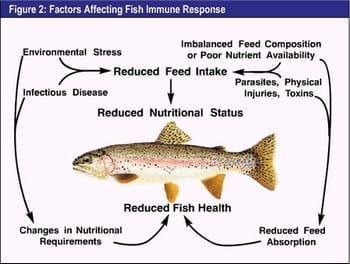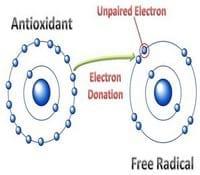Role of Vitamin-C and Multivitamin Diets for Enhacement of Immunity, Growth and Biological Performance in Shrimps/ Fishes
Published: August 20, 2014
By: Mr. Prakash Chandra Behera, Technical Manager (Aqua Division), PVS Group, India
Introduction
Good nutrition in aquaculture systems is essential to economically produce a healthy and high quality product. Vitamins are essential nutrients found in foods. They perform specific and vital functions in a variety of body systems and these are crucial for maintaining optimal health. Vitamins are a heterogeneous group of organic compounds essential for the growth and maintenance of aquatic animal life. The majority of vitamins are not synthesized by the fish body or at a rate sufficient to meet the aquatic animals needs.
Vitamins are distinct from the major food nutrients (proteins, lipids, and carbohydrates) in that they are not chemically related to one another. They are present in very small quantities within animal and plant foodstuffs. They are required by the fish body in trace amounts. Approximately 15 vitamins have been isolated from biological materials and their essentiality depending on the species, the growth rate of the animal, feed composition, and the bacterial synthesizing capacity of the gastro-intestinal tract of the animal. In general, all fish display distinct morphological and physiological deficiency signs when individual vitamins are absent from the diet.
The two different types of vitamins are Fat-soluble vitamins and Water-soluble vitamins.
Fat-soluble vitamins dissolve in fat before they are absorbed in the bloodstream to carry out their functions. Excesses of these vitamins are stored in the liver, and are not needed every day in the diet.The fat-soluble vitamins are absorbed from the gastrointestinal tract in the presence of fat and can be stored within the fat reserves of the body whenever dietary intake exceeds metabolic demands .
Fat soluble: Vitamin A1 (Retinol, retinal, retinoic acid), Vitamin A2 (Dehydroretinol), Vitamin D2 (Ergocalciferol), Vitamin D3 (Cholecalciferol), Vitamin E (Tocopherol, tocotrienols), Vitamin K1 (Phylloquinone), Vitamin K2 (Menaquinone), Vitamin K (Menadione)
Water-soluble vitamins dissolve in water and are not stored by the body. Since they are eliminated in urine and require a continuous daily supply in fish/shrimp diet. Water-soluble vitamins are easily destroyed or washed out during food storage or preparation. Body stores being rapidly depleted in the absence of regular dietary water-soluble vitamin sources.
Water Soluble: Thiamin (Vitamin B1), Riboflavin (Vitamin B2), Niacin (Vitamin B3) Vitamin B6 (Pyridoxol, pyridoxal, pyridoxamine), Pantothenic acid (Vitamin B5) Biotin (Vitamin H, vitamin B8) , Folic acid (Vitamin M, Vitamin Bc, Vitamin B9) Vitamin B12 (Cobalamin), Choline (Gossypine), Vitamin C ( Ascorbic acid)
BENEFITS OF MULTIVITAMINS:
- Aids normal bone, tooth and exoskeleton development
- Maintains the health of the skin and membranes
- Helps in energy metabolism and tissue formation
- Enhances calcium and phosphorus absorption and utilization
- Promotes immune stimulation
- Decreases the diseases incidence.
- Acts as antioxidant
- Acts like ‘Cement’ for connective tissues
- Helps for wound healing
- Makes iron absorption
- Benefits for healthy eye & vision .
- Involve in a large number of biological processes.
- Creates collagen in the body
- Makes the skin, joints, exoskeleton and bones strong.
- Regulates moult phase in shrimps
Biological Functions of Water Soluble Vitamins
Thiamine (B1) : aids growth, digestion, fertility, nervous system, carbohydrate metabolism and oxidation of glucose
Riboflavin (B2): vision, enzyme functioning ,energy metabolism, respiration of poorly vascularised tissues, metabolism of carbohydrates, fats and proteins.
Pyroxidine (B6): enzyme secretion , protein and carbohydrate metabolism.
Pantothenic Acid (B5): adrenal functioning, cholersterol production, normal physiology and metabolism ,
Nicotinic Acid (niacin, B3) : lipid, protein and amino acid metabolism
Biotin (H): enzyme secretion, purine and lipid synthesis, oxidation of lipids and carbohydrates,
Folic Acid (M): blood cell formation, blood glucose regulation and various metabolism
Cyanocobalamin (B12): enzyme systems, cholesterol metabolism
Inositol: cell membrane permeability, structural component of skeletal, heart and brain tissue, growth of liver and bone marrow cells, liver lipid (cholesterol) transport, synthesis of RNA.
Choline: better growth and FCR, maintenance of cell structure and the transmission of nerve impulses, transport of lipid within the body.
Biological Functions of Fat-Soluble vitamins
Retinol(Vitamin A): highest biological activites, normal vision, form a visual pigments, maintenance of the mucous secreting epithelial tissues of the reproductive tract, skin, bone and gastro-intestinal tract, protecting mucous membranes and developing bone tissue, epithelial cell metabolism, release of proteolytic enzymes from lysosomes.
Cholecalciferol (Vitamin D) : calcium and phosphorus metabolism, growth of bone tissue, synthesis of the calcium binding protein, the conversion of organic phosphorus to inorganic phosphorus in bone, maintenance of blood calcium level, and the deposition and oxidation of citrate in bone.
Tocopherol: act as lipid-soluble extracellular and intracellular antioxidants, protect the highly unsaturated fatty acids, important role in cellular respiration, biosynthesis of DNA and coenzyme Q.
Phylloquinone (Vitamin K): maintenance of normal blood coagulation, electron transport and oxidative phosphorylation in micro-organisms
Vitamin C
Vitamin C probably is the most important because it is a powerful antioxidant and immunomodulator for fishes/ shrimps. The fish and shrimp body needs vitamin C( ascorbic acid or ascorbate) to remain in proper health condition.
- Vitamin C makes various benefits to the fish/ shrimp body by holding cells together through collagen synthesis. Collagen is a connective tissue that holds muscles, bones, and other tissues together. Collagen is also needed for the healing of wounds.
- Vitamin C also requires in wound healing, bone and tooth formation, strengthening blood vessel walls, improving immune system function, increasing absorption and utilization of iron, and acting as an antioxidant.
- Vitamin C works with vitamin E as an antioxidant and plays a crucial role in neutralizing free radicals throughout the body..
- Vitamin C reduces the effects of toxic chemicals in water and prevent negative effects of water temperature fluctuations.
- Vitamin C increases intestinal absorption of iron from plant-based foods.
- VitaminC enhances in immune response.
- Vitamin C helps synthesize carnitine, adrenaline, epinephrine, the neurotransmitter serotonin, the thyroid hormone thyroxine, bile acids, and steroid hormones.
- Vitamin C regulates the moult phase and helps in quick formation of exoskeleton in shrimps.
Major Functions of Vitamin C
Water temperature: Vitamin C diets helps to fishes during low temperature period for enhancing digestion efficiency and thereafter promote growth rate.
Stress : The ascorbic acid concentrations in tissues in fish change during stressful periods Vitamin C prevents from various stress such as: environmental stress, handling stress, pathogenic stress, transportation stress, osmotic stress etc, of fishes and shrimps.
Toxic Gasses Eliminator: The ascorbic acid helps to eliminate the adverse effect of ammonia on growth of fishes and reduces the toxic effect of nitrite levels in intensive aquaculture systems.
Wound healing: Vitamin C makes collagen formation in body and helps in quick for optimal wound repair in fishes and shrimps.
Reproduction: Vitamin C helps in reproduction systems of fishes and shrimps such as growth of healthy brooders, proper egg and sperm formation, optimum fecundity, improve hatchability, healthy larval and fry conditions etc.
Larval Nutrition: Diet with vitamin C acts fast development of embryo /larvae and early fry stages with reduction of mortality in early stages of fishes /shrimps.
Immunity: Vitamin C is at the top of the list among natural immune boosters for fish /shrimp body.Vitamin C have the immune-stimulating properties and compensate the immune-depression. It offers protection to fish / shrimp immune system by encouraging the activity of immune system cells including neutrophils and phagocytes. The collagen prevents various diseases caused by bacteria and viruses . Mucus helps in preventing microorganisms from entering to the body through the skin, gills and gastrointestinal mucosa. Vitamin C prevents bacteria from adhering to epithelial cells. High concentration of vitamin C in white blood cells enables the immune system to function properly by providing protection against oxidative damage from free radicals generated during their action against bacterial, viral, or fungal infections.


Antioxidant: Free radicals, such as superoxide, hydroxyl ions and nitric oxide all contain an unpaired electron. These radicals can have a negative effect on cells causing oxidative damage that leads to cell death. Antioxidants, such as vitamin E & Vitamin C, prevent cell damage by binding to the free radical and neutralising its unpaired electron. Ascorbic acid is well known for its antioxidant activities. Ascorbate acts as a reducing agent to reverse oxidation in aqueous solution.
Dietary Vitamin Requirements
The dietary vitamin requirements of fish and shrimp have been determined by feeding graded levels of each vitamin. Most fishes and shrimps, the quantitative dietary vitamin requirements will depend upon a number of important factors including:
- The feeding behavior, size and growth rate of the fish or shrimp species cultured.
- The vitamin synthesizing capacity of the gut micro-flora of the fish or shrimp species .
- The intended culture system to be used (ie. intensive, semi-intensive or extensive) and availability of natural food organisms within the water body.
- The nutrient content of the diet used.
- The manufacturing process to be used for the production of the feed ration.
- The physico-chemical characteristics of the water body and physiological condition of the fish or shrimp species cultured.
Leaching of water soluble vitamins
In contrast to the fat soluble vitamins (A, D, E and K), the water soluble vitamins can be readily lost from the feed through leaching prior to ingestion by the fish. In general, the smaller the feed particle size and the longer the feed remains uneaten in water, the greater the loss of water soluble nutrients. L-ascorbic acid (vitamin C) has been found to be particularly prone to loss through leaching.
Deficiencies of vitamins due to dietary antibiotic addition
The use of feed antibiotics to treat disease outbreaks may destroy the vitamin synthesizing capacity of the gut microflora of fish which in omnivorous/ herbivorous species may play an important role toward the vitamin requirements of the animal.
Vitamin Toxicity
In contrast to the water soluble vitamins, fish and shrimp accumulate fat soluble vitamins under conditions where dietary intake exceeds metabolic demand. Under certain circumstances accumulation is such that a toxic condition (hypervitaminosis) may be produced.
VitaminToxicity signs : Reduced growth and haematocrit, severe necrosis/erosion of anal, caudal, pelvic and pectoral fins, scoliosis, lordosis, increased mortality, pale yellow livers,lethargy, dark colouration, poor feed efficiency, Reduced blood erythrocyte concentration
Vitamin deficiency and signs in fish and shrimp
RIBOFLAVIN: Anorexia, poor growth, corneal vascularisation, cloudy lens, spinal deformities, severe fin erosion, fin haemorrhage, rapid opercular movement, apparent muscular weakness, light or dark pigmentation, photo- phobia, lethargy, anaemia
NIACIN :Anorexia, poor growth, reduced feed efficiency, dark colouration, erratic swimming, muscular spasms while resting
PANTOTHENIC ACID: Anorexia, reduced growth, gill necrosis/clubbing, high mortality, pale gill and liver, anaemia, mucous covered gills, sluggish, opercules distended
THIAMINE: Anorexia, poor growth, dark colouration, mortality
PYRIDOXINE: Nervous disorders, hyperirritability, anorexia, ataxia, erratic and rapid swimming, greenish-blue colouration of skin, anaemia, rapid and gasping breathing
BIOTIN : Anorexia, reduced growth, increased mortality, poor feed efficiency, blue-slime disease (brook trout only), lesions in the colon, thick gill lamellae, pale gills
FOLIC ACID: Anaemia, poor growth, anorexia, lethargy, dark colouration, pale gills and liver, exopthalmia, distended abdomen with ascites fluid
VITAMIN B12 : Anorexia, reduced growth, anaemia, fragmented erythrocytes, poor feed efficiency, dark pigmentation
CHOLINE :Reduced growth, fatty liver, poor feed efficiency, haemorrhagic kidney and intestine
INOSITOL: Reduced growth, distended abdomen, dark colour, skin and fin lesions/haemorrhages, loss of skin mucosa ,increased gastric emptying time
VITAMIN C: Reduced growth, internal/fin haemorrhage, distorted/twisted gill filaments, poor wound repair, increased mortality rate, reduced egg hatchability, Black death syndrome (blackening of exoskeleton; melanized haemocytic lesions), reduced wound repair and feed efficiency, poor growth and survival
VITAMIN A: Reduced growth, exopthalmia, depigmentation, clouding and thickening of corneal epithelium, degeneration of the retina, Anorexia, faded body colour, fin and skin haemorrhages, exopthalmia, abnormal/warped gill operculae
VITAMIN D: Reduced growth and feed efficiency, anorexia, tetany, elevated liver/muscle lipid content and plasma, Reduced survival rate
VITAMIN K: Increased blood clotting time, anaemia, haemorrhagic gills, eyes, vascular tissue, Skin haemorrhages
VITAMIN E: Reduced growth, exopthalmia, ascites, anaemia, clubbed gills, epicarditis, ceroid deposition in spleen, increased mortality, pale gills, erythro- cyte fragility, muscle damage/degeneration, reduced egg hatching rate/spawning efficiency, Reduced survival
PANTOTHENIC ACID: Anorexia, reduced growth, gill necrosis/clubbing, high mortality, pale gill and liver, anaemia, mucous covered gills, sluggish, opercules distended
THIAMINE: Anorexia, poor growth, dark colouration, mortality
PYRIDOXINE: Nervous disorders, hyperirritability, anorexia, ataxia, erratic and rapid swimming, greenish-blue colouration of skin, anaemia, rapid and gasping breathing
BIOTIN : Anorexia, reduced growth, increased mortality, poor feed efficiency, blue-slime disease (brook trout only), lesions in the colon, thick gill lamellae, pale gills
FOLIC ACID: Anaemia, poor growth, anorexia, lethargy, dark colouration, pale gills and liver, exopthalmia, distended abdomen with ascites fluid
VITAMIN B12 : Anorexia, reduced growth, anaemia, fragmented erythrocytes, poor feed efficiency, dark pigmentation
CHOLINE :Reduced growth, fatty liver, poor feed efficiency, haemorrhagic kidney and intestine
INOSITOL: Reduced growth, distended abdomen, dark colour, skin and fin lesions/haemorrhages, loss of skin mucosa ,increased gastric emptying time
VITAMIN C: Reduced growth, internal/fin haemorrhage, distorted/twisted gill filaments, poor wound repair, increased mortality rate, reduced egg hatchability, Black death syndrome (blackening of exoskeleton; melanized haemocytic lesions), reduced wound repair and feed efficiency, poor growth and survival
VITAMIN A: Reduced growth, exopthalmia, depigmentation, clouding and thickening of corneal epithelium, degeneration of the retina, Anorexia, faded body colour, fin and skin haemorrhages, exopthalmia, abnormal/warped gill operculae
VITAMIN D: Reduced growth and feed efficiency, anorexia, tetany, elevated liver/muscle lipid content and plasma, Reduced survival rate
VITAMIN K: Increased blood clotting time, anaemia, haemorrhagic gills, eyes, vascular tissue, Skin haemorrhages
VITAMIN E: Reduced growth, exopthalmia, ascites, anaemia, clubbed gills, epicarditis, ceroid deposition in spleen, increased mortality, pale gills, erythro- cyte fragility, muscle damage/degeneration, reduced egg hatching rate/spawning efficiency, Reduced survival
Related topics
Authors:
Join to be able to comment.
Once you join Engormix, you will be able to participate in all content and forums.
* Required information
Would you like to discuss another topic? Create a new post to engage with experts in the community.
Create a postYEDI VET TARIMSAL FAA. TIC. VE LTD. STI
29 de diciembre de 2015
Hello I am Mete from TURKEY.Thank you for your information.
I have got liquid Vit C(%25)what is your advice dose for fish?
27 de noviembre de 2015
Which nature product.have high qntyty vit c and how to use in shrimp feed sir?






.jpg&w=3840&q=75)